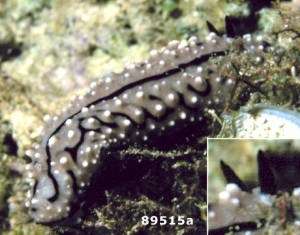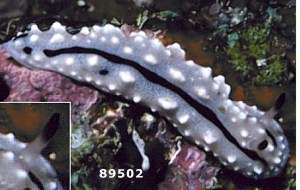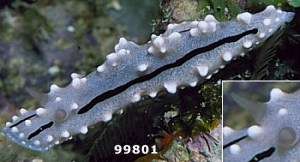Re: Phyllidiella cf. rudmani
April 29, 2000
From: Mary Jane Adams

Dear Bill,
I found another slide of Phyllidiella cf. rudmani taken from a slightly higher angle. Looking at the slide with an 8 X loupe, I believe that the base of the rhinophore is white. (89515a)
While searching through my files, I found some other similar images. The one that looks the most like the photos of Phyllidiella rudmani on your webpage was shot in Milne Bay in August, 1995. Depth unrecorded, length approx. 40 mm. (89502)
However, I also have an image of another similar Phyllidiella from near Kavieng, PNG, that has completely white rhinophores. It was photographed in Sept 1998. Depth unrecorded, length 42mm. (99801)
This group of slugs is really confusing!
Thanks for your impressions,
Mary Jane Adams
mjadams@earthlink.net


Dear Mary Jane,
Thanks for the extra photos - not that they make the situation easier!
I think from your extra photo [89515a] that we can consider the rhinophore to have a 'pink' base which would suggest it is probably a colour form of P. rudmani. Your new photo [89502] is a pretty good fit to 'typical' Phyllidiella rudmani.
However your last photo [99801] is another puzzle. The compound tubercles are reminiscent of Phyllidiopsis krempfi or perhaps Phyllidiopsis pipeki as well as Phyllidiella rudmani. However the colourless rhinophores are a problem. The only Phyllidiopsis with similarly coloured rhinophores is Phyllidiopsis shireenae but the arrangement of black lines is rather different.
One possibility is that the rhinophores are regrowing after being damaged (eaten) which would suggest P. rudmani as a simple solution. Another problem however is that it seems to have rhinotubercles [the small tubercle associated with the rhinophore pocket in Phyllidia and Fryeria]. If so, I don't know what to suggest, other than to put it to one side at present.
I'm afraid there doesn't seem to be an easy solution,
Best wishes,
Bill Rudman.
Related messages
-
Phyllidiella from Papua New Guinea
From: Mary Jane Adams, April 25, 2000
